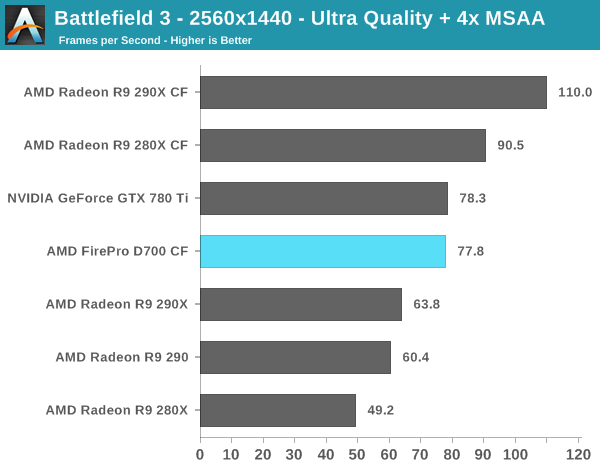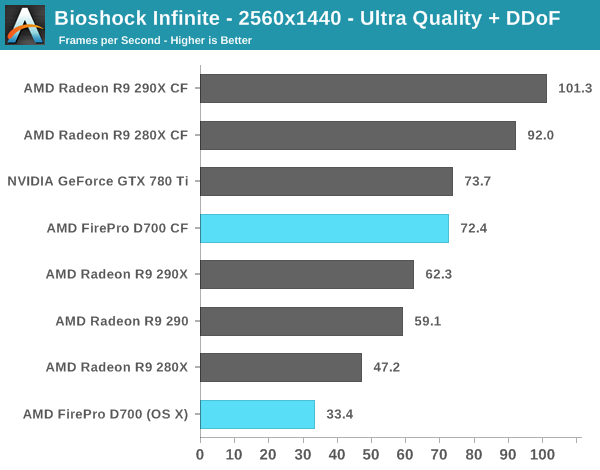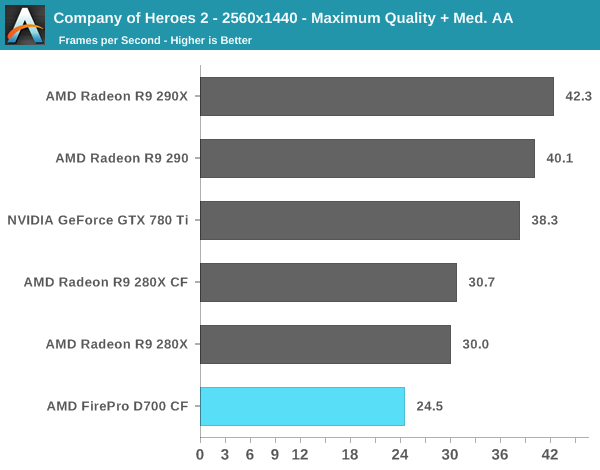The Mac Pro Review (Late 2013)
by Anand Lal Shimpi on December 31, 2013 3:18 PM ESTGaming Performance
As I mentioned earlier, under OS X games have to specifically be written to use both GPUs in the new Mac Pro. Under Windows however it's just a matter of enabling CrossFire X. I ran the new Mac Pro with dual FirePro D700s through a few of Ryan's 2014 GPU test suite games. The key comparison here is AMD's Radeon R9 280X CF. I've put all of the relevent information about the differences between the GPUs in the table below:
| Mac Pro (Late 2013) GPU Comparison | ||||||
| AMD Radeon R9 280X | AMD FirePro D700 | |||||
| SPs | 2048 | 2048 | ||||
| GPU Clock (base) | 850MHz | 650MHz | ||||
| GPU Clock (boost) | 1000MHz | 850MHz | ||||
| Single Precision GFLOPS | 4096 GFLOPS | 3481 GFLOPS | ||||
| Texture Units | 128 | 128 | ||||
| ROPs | 32 | 32 | ||||
| Transistor Count | 4.3 Billion | 4.3 Billion | ||||
| Memory Interface | 384-bit GDDR5 | 384-bit GDDR5 | ||||
| Memory Datarate | 6000MHz | 5480MHz | ||||
| Peak GPU Memory Bandwidth | 288 GB/s | 264 GB/s | ||||
| GPU Memory | 3GB | 6GB | ||||
Depending on thermal conditions the 280X can be as little as 17% faster than the D700 or as much as 30% faster, assuming it's not memory bandwidth limited. In the case of a memory bandwidth limited scenario the gap can shrink to 9%.
All of the results below are using the latest Radeon WHQL drivers at the time of publication (13-12_win7_win8_64_dd_ccc_whql.exe) running 64-bit Windows 8.1. Keep in mind that the comparison cards are all run on our 2014 GPU testbed, which is a 6-core Ivy Bridge E (i7-4960X) running at 4.2GHz. In other words, the other cards will have a definite CPU performance advantage (20 - 30% depending on the number of active cores).
You'll notice that I didn't run anything at 4K for these tests. Remember CrossFire at 4K is still broken on everything but the latest GCN 1.1 hardware from AMD.

Battlefield 3 starts out telling the story I expected to see. A pair of 280Xes ends up being 16% faster than the dual FirePro D700 setup in the Mac Pro. You really start to get an idea of where the Mac Pro's high-end GPU configuration really lands.

Bioshock ends up at the extreme end of what we'd expect to see between the 280X and D700. I tossed in a score from Bioshock under OS X, which obviously doesn't have CF working and ends up at less than half of the performance of the D700. If you're going to do any heavy 3D gaming, you'll want to do it under Windows still.

Not all games will scale well across multiple GPUs: Company of Heroes 2 is one of them. There's no performance uplift from having two 280Xes and thus the D700 performs like a slower single GPU R9 280X.


Metro is the one outlier in our test suite. Although CrossFire is clearly working under Windows, under Metro the D700 behaves as if it wasn't. I'm not sure what's going on here, but this does serve as a reminder that relying on multi-GPU setups to increase performance does come with a handful of these weird cases - particularly if you're using non-standard GPU configurations.










267 Comments
View All Comments
tipoo - Thursday, January 2, 2014 - link
But can you use them as Firepros when dual booting Windows?hoboville - Thursday, January 2, 2014 - link
Nvidia GPUs run those applications faster, the Mac Pro GPUs, while having more RAM, are underclocked to meet temps because of the small form factor. If you don't need ECC, and aren't using more than 3 GB of RAM, build a PC with R9 280Xs. If you want a serious workstation, buy Nvidia.HydraMac - Tuesday, December 31, 2013 - link
@Ananad - Hey interesting results with that power virus and throttling but what would happen doing the same thing to the older more conventional MP running 2xGPU cards as well? I'd be curious how the old school machine handled the same type of thrashing. It would give a frame of reference as opposed to the results being shown in a vacuum i.e. unified core vs. conventional machine cooling.justizin - Tuesday, December 31, 2013 - link
"All of that being said, I don’t expect there to be a lot of cross shopping between DIY builders and those looking for a Mac Pro."Actually, everyone I've ever known who worked at Apple was a hackintosh enthusiast and had a home-build machine faster than a Mac Pro at a far lower price. I assume since Apple has curtailed its' employee discounts in recent years, this trend will only continue to grow.
Kevin G - Wednesday, January 1, 2014 - link
For consumer systems, yes.For professional level systems, there indeed will be little overlap. The professional level DIY market is quiet small as it is preferred that companies order from an OEM like Dell or HP to get a centralized warranty, support and service. There is a price premium there from the OEM's but they do tend to follow through on their support contracts. This saves time instead of having to go through multiple vendors for support and RMA's equipment. The prices of professional level equipment on the PC side (Xeons, ECC memory, and graphics) don't offer the same mass market price benefits as consumer parts.
darkcrayon - Wednesday, January 1, 2014 - link
Exactly. If the DIY market were so large for Pro systems, there's no way HP or Lenovo could justify having them in their product line- and a DIY Windows machine doesn't even need a hacked OS.newrigel - Wednesday, March 1, 2017 - link
You're full of BS man... They are hassle to maintain and if you want to get work done that's the wrong machine to have.... buy cheap and be cheap because that's what you are... ghetto productions!!!!wkw - Tuesday, December 31, 2013 - link
10 USB 2 ports on the Lenovo. Sweeeeeeetnewrigel - Wednesday, March 1, 2017 - link
Ever heard of a USB hub?????El Aura - Tuesday, December 31, 2013 - link
Is the preferred order of TB port usage really 1, 2, 5 and not 1, 3, 5?